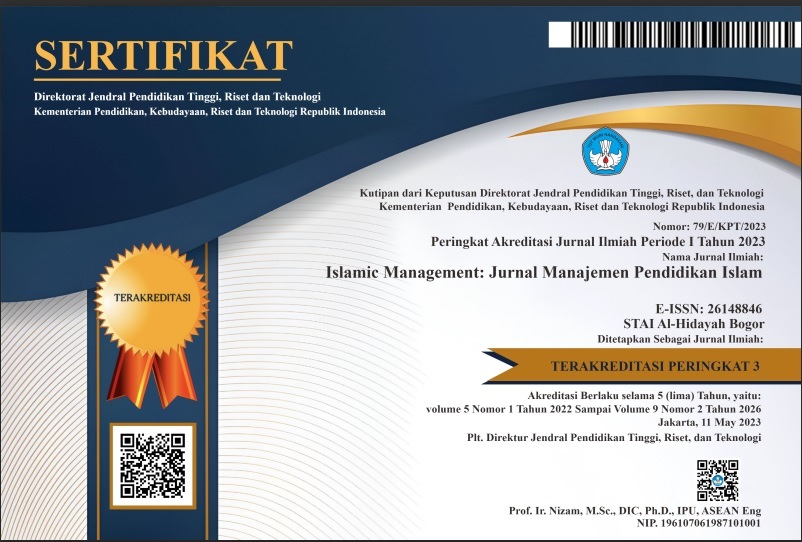EDUCATIONAL MARKETING MIX INNOVATION TO INCREASE STUDENT ENTRY INTEREST
DOI:
https://doi.org/10.30868/im.v7i001.7378Keywords:
Education Marketing Strategy, Marketing Mix, Interest In SchoolAbstract
This study aims to analyze innovations in education marketing strategies at MI Al-Wathoniyah 22 Bekasi in increasing interest in entering schools. The qualitative method used in conducting this research is qualitative. Research data collection is done through interviews, observations, and document studies. The data analysis techniques are reducing data, presenting data, and finally drawing conclusions. The results showed that MI Al-Wathoniyah 22 innovated by implementing and maximizing seven marketing mixes: products, places, prices, promotions, human resources, physical evidence, and processes. Innovation in the educational marketing mix, especially in physical evidence and process elements. The use of advanced technology in learning, the design of adequate physical facilities, and the implementation of efficient admissions procedures are examples of innovations that can increase the attractiveness of schools and improve the overall quality of education services. This will increase the interest in prospective students entering the school.
References
Booms, B. H., & Bitner, M. J. (1981). Marketing Strategies and Organization Structures for Service Firms.
Effendi, U. (2014). Asas manajemen. Rajawali Pers.
Green, M. (2012). Marketing Education: A Guide to Successful Strategies for Schools and Universities. Routledge.
Ismuratno, I., & Hamdani, M. K. (2021). Implementasi strategi pemasaran jasa pendidikan di Lembaga Sekolah Dasar Islam Insan Cendikia Pacitan. Jurnal Studi Pemikiran Pendidikan Agama Islam, 19(1).
Keller, K. L. (2015). Strategic Brand Management: Building, Measuring, and Managing Brand Equity (4th ed.). Pearson.
Keller, K. L. (2015). Strategic brand management: Building, measuring, and managing brand equity. Pearson.
Keller, K. L., & Kotler, P. (2020). How to choose the right pricing strategy for your business.
Kotler, P., & Fox, K. F. A. (1995). Strategic Marketing for Educational Institutions (2nd ed.). Prentice Hall.
Kotler, P., & Keller, K. L. (2022). Marketing Management (16th ed.). Pearson.
Kotler, P., Armstrong, G., Harris, L. C., & Piercy, N. (2016). Principles of marketing (16th ed.). Pearson.
Kotler, P., et al. (2021). Principles of marketing. Pearson.
Nur’aini, F., & Fatimah, D. (2016). Teknik analisis SWOT pedoman menyusun strategi yang efektif & efisien serta cara mengelola kekuatan & ancaman. Quadrant.
Nurhasanah, S. (2023). Statistika pendidikan (Teori, aplikasi, dan contoh kasus) (2nd ed.). Salemba Humanika.
Nurhasanah, S., et al. (2022). Metode penelitian kuantitatif dan kualitatif (Teori, aplikasi, dan contoh kasus). Media Edu Pustaka.
Rangkuti, F. (1999). Analisis SWOT teknik membedah kasus bisnis. Gramedia Pustaka Utama.
Rogers, E. M. (2003). Diffusion of innovations (5th ed.). Free Press.
Rosen, E. (2009). The anatomy of buzz revisited: Real-life lessons in word-of-mouth marketing. Currency/Doubleday.
Sadiman, A. S. (2009). Educational Communication and Technology (5th ed.). Open University Press.
Sadiman, A. S. (2009). Media pendidikan: Pengertian, pengembangan, dan pemanfaatannya. Rajawali Pers.
Trott, P. (2017). Innovation Management and New Product Development (6th ed.). Pearson
Wijaya, D. (2016). Marketing Services: Fundamentals and Strategies. Salemba Empat.
Yusuf, M. (2018). Educational Marketing: Strategies and Applications for School Leaders. Sage Publications.
Downloads
Published
How to Cite
Issue
Section
Citation Check
License
Copyright (c) 2024 Siti Nurhasanah, Puji Rahayu, Elvir Sitna Hajar

This work is licensed under a Creative Commons Attribution-ShareAlike 4.0 International License.
Authors who publish with this journal agree to the following terms:
- Authors retain copyright and grant the journal right of first publication with the work simultaneously licensed under a Creative Commons Attribution License that allows others to share the work with an acknowledgment of the work's authorship and initial publication in this journal.
- Authors are able to enter into separate, additional contractual arrangements for the non-exclusive distribution of the journal's published version of the work (e.g., post it to an institutional repository or publish it in a book), with an acknowledgment of its initial publication in this journal.
- Authors are permitted and encouraged to post their work online (e.g., in institutional repositories or on their website) prior to and during the submission process, as it can lead to productive exchanges, as well as earlier and greater citation of published work (See The Effect of Open Access).






